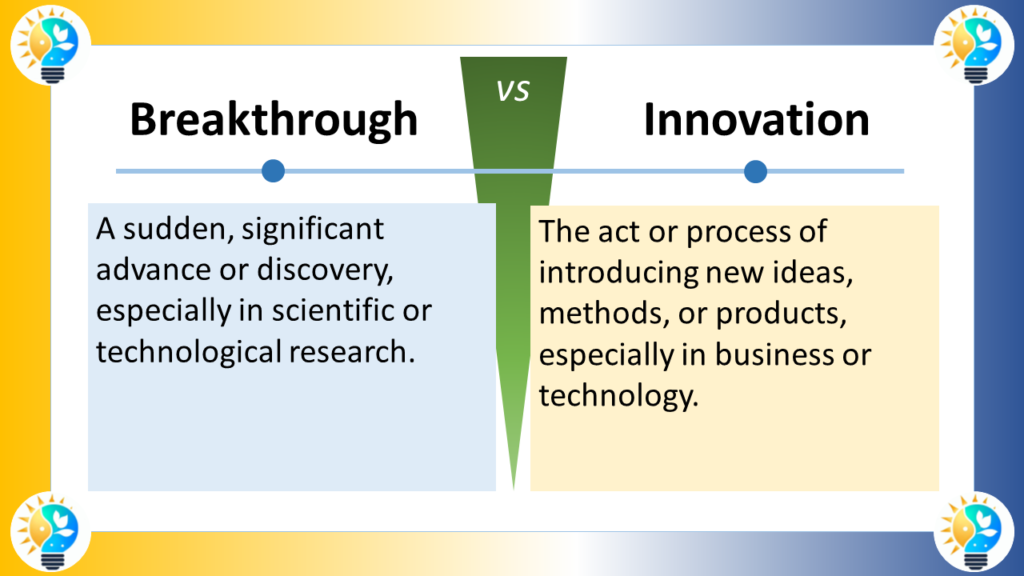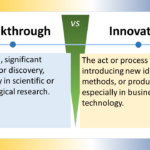The difference between innovation and breakthrough revolves around the magnitude and impact of the change. Innovation is a broad term that refers to the application of better solutions to meet new requirements or existing market needs.
A breakthrough is a specific type of innovation that signifies a significant discovery or development that enables a quantum leap in knowledge or technology.

Definition
Innovation
Innovation is the process of translating an idea or invention into a good or service that creates value or for which customers will pay.
- Characteristics of Innovation:
- Applicability: Can be implemented in various forms, such as products, services, or processes.
- Improvement: Usually represents an upgrade or an enhancement of existing solutions.
- Incremental or Radical: Can range from minor improvements to radical changes.
Breakthrough
Breakthrough refers to an instance of achieving significant success in a particular sphere or endeavor, often overcoming a significant problem or barrier.
- Characteristics of Breakthrough:
- Monumental Success: Represents a major achievement that was previously unattainable.
- Overcoming Barriers: Involves surpassing significant challenges or limitations.
- Pioneering: Often leads to new avenues of research or development.
More Synonyms on innovation, innovate and innovative
Innovation Terms

Innovation is considered as a driving force in progress.
It includes the introduction of novel ideas, methods, or products that bring positive change and advancement.
For more information about innovations, check our glossary
Relationship and Relevance
Breakthroughs can be seen as a subset of innovations. All breakthroughs are innovations due to their nature of introducing significant change, but not all innovations qualify as breakthroughs because they may represent smaller, incremental improvements rather than monumental leaps forward.
Based on the search results, the key differences between innovation and breakthrough innovation are:
Innovation
- Innovation is the broad process of creating something new that provides value, whether it is a new product, service, business model, or process.
- Innovation can range from incremental improvements to existing offerings to more radical, disruptive changes.
Breakthrough Innovation
- Breakthrough innovation specifically refers to innovations that involve significant changes to the business model or underlying technology.
- Breakthrough innovations open up new markets, change how customers interact with a product/service, and provide substantially more value than existing offerings.
- Breakthrough innovations are less common than incremental innovations, as they require greater investment of capital, time and resources and carry higher risk.
- Examples of breakthrough innovations include the invention of the transistor by Bell Labs or Zipcar's new car rental model.
In summary, while all breakthrough innovations are a type of innovation, not all innovations qualify as breakthroughs. Breakthrough innovations are a specific subset of innovations that involve fundamental changes to technology or business models, rather than just incremental improvements. Breakthrough innovations have the potential for greater impact, but also carry higher risk and resource requirements.
Context for Using Each Term
- Innovation is used to describe the continuous process of improvement and adaptation, which may involve the development of new products, services, or methods that improve life or efficiency.
- Breakthrough is used when a remarkable achievement occurs that changes the fundamental understanding or possibilities within a particular field, such as a medical cure for a previously incurable disease.
Example of Utilization
The development of a new mobile app that simplifies online shopping with a user-friendly interface is an innovation. The discovery of penicillin, which revolutionized the treatment of bacterial infections and opened up the field of antibiotics, is a classic example of a breakthrough.
In essence, while innovation is a necessary step in the path of progress, often involving the iterative improvement of technologies and systems, a breakthrough is a transformative moment that marks a radical leap forward, enabling advancements that were once considered nearly impossible.
- A Look at Breakthrough Versus Incremental Innovation
- Breakthrough Innovation
- Understanding the Differences between Breakthrough and Incremental Innovation
- Incremental, Breakthrough, and Radical Innovation: What's the Difference?
FAQ
Q1: Can an innovation become a breakthrough?
A1: Yes, sometimes what starts as an innovation can later be recognized as a breakthrough if its impact proves to be transformative.
Q2: Are breakthroughs always technological?
A2: No, breakthroughs can occur in various fields, including science, medicine, social sciences, and even business strategies.
Q3: How long does it take to recognize a breakthrough?
A3: The recognition of a breakthrough can be immediate in some cases, while in others it may take time for the full impact to be understood and acknowledged.
Q4: Are breakthroughs always positive?
A4: While breakthroughs often lead to positive advancements, they can also have unintended consequences or ethical implications that need to be carefully considered.
Q5: How do organizations foster both innovation and breakthroughs?
A5: Organizations often encourage continuous innovation while also investing in high-risk, high-reward research that might lead to breakthroughs, balancing short-term improvements with potential long-term transformative discoveries.

